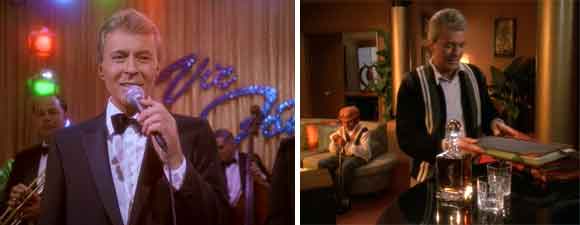Retro Review: Treachery, Faith and the Great River
7 min readOdo tries to rescue a clone of Weyoun who wishes to defect while Nog tries to help O’Brien repair the Defiant.
Plot Summary: Odo is summoned to a remote planet by a onetime Cardassian informant, only to be greeted by Weyoun instead. The Vorta calls Odo a god and asks for asylum, claiming that he wants to defect because the Dominion should not win the war. Eager to see whether Weyoun will provide Starfleet with valuable intelligence no matter what his real motives might be, Odo takes him aboard his runabout, where they are quickly hailed by Damar and another Weyoun, who explains that when the fifth clone of that name died in an accident for which Damar was probably responsible, the Dominion created a sixth clone – currently sitting beside Odo – who was found to be defective in that he did not serve the will of the Founders. Now the seventh clone wants the sixth to trigger his termination implant, but Weyoun 6 refuses to do so because the Founder Odo wants him alive. When Weyoun 7 sends Jem’Hadar ships to capture the runabout, Weyoun 6 teaches Odo how to destroy Jem’Hadar shields. A horrified Weyoun 7 realizes that in order to keep Dominion secrets safe, he must become complicit with Damar in killing a shapeshifter. The female Founder who was once Odo’s lover demands status updates, but she looks ill and leaves before learning of this plan. Meanwhile, on the station, O’Brien is unable to get a necessary part to repair the Defiant and agrees to let Rom trade for it, then is shocked when Rom loans out the captain’s desk and gives away Martok’s blood wine. Weyoun 6 tells Odo that the Great Link is dying and that Odo might become the last living Founder, giving him the ability to reshape the Dominion as a less violent entity. When Weyoun 7 and Damar track them down, Weyoun 6 activates his termination implant rather than allowing Odo to be killed, dying at peace in the arms of a god. Back on the station, nearly everyone is happy because Rom has retrieved better replacements for all their missing items and gotten the part O’Brien needs through what Rom calls the Great Material Continuum, but Odo tells Kira he now knows that no matter who wins the war, he is going to lose people whom he considers his own.
Analysis: “Treachery, Faith and the Great River” has such a wordy, metaphysical-sounding title that anyone could be forgiven for expecting an eloquent, philosophical episode. Instead its central story is full of bombshells, and I don’t mean the sort that come from Jem’Hadar weapons; these are the sort that resonate deeply and personally, and they only seem more shattering when one knows the resolutions for the show’s major arcs. Even the lighthearted B story, in which Nog demonstrates that Ferengi devotion to acquisition is based on the concept of the Great Material Continuum – a version of karma in which what goes around comes around in a physical sense, so that the universe and each world within it depends upon the trading of goods and services – gives the first real depth and profundity to Ferengi capitalist culture that we’ve witnessed. Despite the handful of stand-alone episodes and focus on Ezri since the start of the season, it’s apparent that the writers have an endgame in sight, and that they intend to address everything from huge social horrors like war and genocide to deeply private issues like the power of romantic love and the bonds of family. The “great river” is meant on the surface to refer to the ebb and flow of supply and demand (or, more generally, desire and fulfillment) and makes a neat nod to the Great Link of the Founders who sent out children like Odo to live as orphans, but it could just as easily refer to the flow of Deep Space Nine, which has been dropping more and more hints that happy endings for some will come at a very high cost to others. The Emissary and the prodigal son of the Founders are closer to the center of the maelstrom, and we’ve seen again and again that their divided loyalties exact a terrible price from them. Because Kira is close to them both – Odo’s lover, Sisko’s greatest supporter as both Starfleet officer and servant of the Prophets – things are going to be extremely difficult for her too, though it’s so nice to see her happy at the start of this episode, in love and relaxed in a way we never really saw her with Bareil or Shakaar.
The Founders are perhaps the most alien species we’ve ever seen on Star Trek. They may not have the omnipotence of the Q or the Organians and they may lack the biological oddity of the Crystalline Entity, but the way they live and operate, while still largely mysterious, makes them utterly fascinating. The same is true of the Jem’Hadar and Vorta. Aliens on the original Star Trek often seem to be deviations on human norms, since even the Horta has traditional mothering instincts (many egg-layers drop their spawn and never see them again) and the humanoid aliens tend to be verbal, social, monogamous, caught between the overprotective and fearful instincts that lead to conflict and the impulse to peace and caring. Enslaved species like the Feeders of Vaal and the Body of Landru adapt quickly when offered freedom. A lot of Starfleet’s wars follow familiar patterns because they’re against aliens with recognizable traits and goals – the Klingons, Romulans, Cardassians all have more in common than not, and even the predatory, mechanical Borg were largely human once, a trait that can be used against them. Nog’s explanation of the Ferengi humanizes them in a different way, since the greed is now explained not as instinctual but philosophical – a funny twist on the idea that the needs of the many outweigh the needs of the one, since Nog’s only payment for all his work is O’Brien’s gratitude and his own satisfaction. It’s ironic, too, to discover that Damar really hates Weyoun, since for a long time Damar seemed primarily selfish in outlook, worried that Cardassians in general and himself personally weren’t getting their due. It wasn’t clear whether all the drinking and womanizing were something he considered his right or just a way to distract himself from Dukat’s terrible alliance with the Founders. It’s increasingly obvious that if Damar could kill these dangerous allies, he’d do it as quickly as he killed Ziyal and with more malice of forethought. And poor Odo, grateful at the start of the episode to have malleable anatomy to pleasure the woman he loves, then learning he could be the sole heir to the entire Dominion and expected to right all the wrongs of his species. Suddenly being the Emissary doesn’t seem quite so hard; at least no one expects Sisko to replace the Prophets.
What’s at stake in the Dominion War isn’t just the safety of the Alpha Quadrant, but what could be the most eye-opening encounter between species we’ve seen, since both sides have things to teach one another that the purported enemies have never imagined. In many ways the solids live down to the Founders’ worst expectations of them as well as the reverse. The moment when Weyoun tells Odo that the changelings are dying, something we suspect from the moment we see the female Founder barely able to function as a leader, obviously changes everything for everyone on either side of the war. Yet though we had met Section 31 when “Treachery, Faith and the Great River” first aired, I never dreamed then that the Federation might be responsible for the Founders’ illness. I just reread the review I wrote when this installment first aired and remembered that I’d thought either the Vorta or the Jem’Hadar (or both) had poisoned their gods, which would have provided a logical if awful resolution to the storylines about those two species. We have witnessed several Jem’Hadar struggling with the idea that they were manufactured for war, designed to be addicts and puppets, longing to be more than the sum of their genetic destiny, and here we have an inkling of the thought that even the submissive Vorta, with a secret, unglamorous yet independent history, may be capable of reclaiming their individuality from the Dominion’s cloning technology. As horrifying as I find the thought of genocide, it makes a certain amount of sense that these two enslaved species – the one bred specifically to serve, the other tricked and trapped by a wounded changeling the early Vorta tried to help – might consider that the equivalent was being done to their own kind already and accept mass murder as the only justice available to them. It even has resonance for the series-long theme of Bajor and the Prophets, for as Kira points out, one species’ wormhole aliens may be another species’ revered gods and yet another species’ terrifying tyrants. If Weyoun 7 can make the decision and give the order to shoot a god who may also be the last survivor of his species, maybe all Vorta are capable of Weyoun 6’s shocking rebellion against the Founders. Maybe we can never generalize about what a species or any individual will choose to believe.







You keep stating that subplot about obtaining the part to repqir the Defiant concerns Rom. That’s incorrect — the plot revolves around Nog. Are we to believe that all Ferengi look alike to you?
Definitely, because Nog and Rom are all men, and with her prejudices against men in general all men must look alike for her
Bullverism much? Your argument instantly collapses under its ridiculousness since Nog isn’t mistaken for Rom outside of the first paragraph and Odo isn’t mistaken for Weyoun nor Rom for Damar.
I loved his episode, still watch it to this day…. the music was profound, the sfx, the concept, “from have to want, and back again.” Cool.
No need to invoke the highly distinguished and equally fictional Ezekiel Bulver…I’m pretty sure Disandat was just kidding
Give us a kiss big tits 🙂